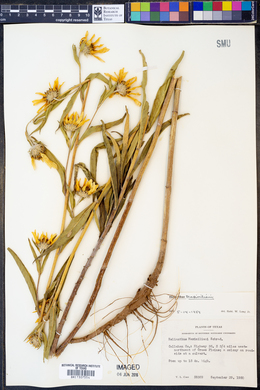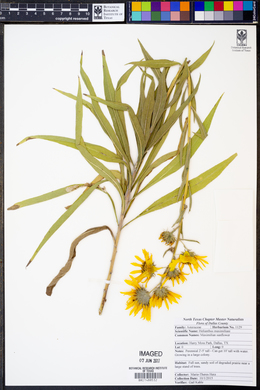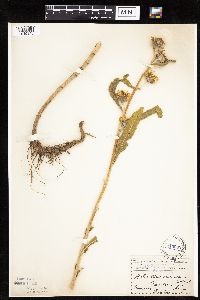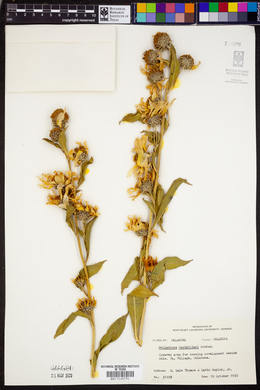Helianthus maximiliani
|
|
|
|
Family: Asteraceae
Maximilian Sunflower, more... (es: girasol)
[Helianthus dalyi Britton, moreHelianthus maximiliani var. iubaris Lunell] |
Perennials, 50-300 cm (rhi-zomatous). Stems erect, 5-30 dm, scabrous to scabro-hispidulous. Leaves cauline; mostly alternate; petioles 0-2 cm; blades (light green to gray-green, 1-nerved, conduplicate) lanceolate, 10-30 × 2-5.5 cm, bases cuneate, margins usually entire, sometimes serrulate, abaxial faces scabrous to scabro-hispid, gland-dotted. Heads (1-)3-15 (often in racemiform to spiciform arrays ). Peduncles 1-11 cm. Involucres hemispheric, 13-28 mm diam. Phyllaries 30-40, lanceolate, 14-20 × 2-3 mm, (margins ciliate) apices acute to attenuate, abaxial faces canescent, gland-dotted. Paleae 7-11 mm, entire or 3-toothed (apices greenish, mucronate, hairy). Ray florets 10-25; laminae (15-)25-40 mm. Disc florets 75+; corollas 5-7 mm, lobes yellow; anthers dark brown or black; appendages usually yellow , sometimes partly dark . Cypselae 3-4 mm, glabrate; pappi of 2 aristate scales 3-4.1 mm. 2n = 34. Flowering late summer-fall. Prairies , fields, waste areas; 0-300(-2100+) m; Alta., B.C., Man., Ont., Que., Sask.; Ala., Ark., Calif., Colo., Conn., Del., D.C., Idaho, Ill., Ind., Iowa, Kans., Ky., Maine, Md., Mass., Mich., Minn., Miss., Mo., Nebr., N.J., N.Y., N.C., N.Dak., Ohio, Okla., Pa., S.C., S.Dak., Tenn., Tex., Utah, Va., Wash., W.Va., Wis., Wyo.; Mexico. Helianthus maximiliani is introduced in eastern Ontario and in Quebec. It appears to be native to midcontinental prairie regions and has spread along railroads and highways into all areas of North America. Its wide dispersal may be aided by cultivation for its attractive, showy floral displays. In addition to the usually conduplicate, single-nerved leaves and spikelike arrangement of the heads, it is distinguished by the whitish-canescent indument of the leaves and stems and the long-attenuate phyllaries.
Perennial with crown-buds, short rhizomes, and thickened, often fleshy-roots; stems usually several, 0.5-3 m, conspicuously pubescent, especially upwards, with mostly short, white, ±appressed hairs; lvs strongly scabrous on both sides, lanceolate, acuminate, 7-20 נ1-3 cm, entire or slightly toothed, firm, pinnately veined, not triplinerved, gradually narrowed to the short, winged petiole or subpetiolar base, generally at least some of them openly folded along the midrib and often falcate, the upper often mainly alternate; heads generally several, the infl tending to be elongate and racemiform; invol bracts narrow, firm, attenuate or subcaudate, loose, often much exceeding the disk, canescent with short white hairs and sometimes basally ciliate; disk yellow, 1.5-2.5 cm wide; rays mostly 10-25, 1.5-4 cm; 2n=34. Prairies and waste ground, often in sandy soil; Man. and Minn. to Mo., w. to B.C. and Tex., and sparingly intr. eastward; perhaps native as far e. as Mich. July-Oct. (H. dalyi, a depauperate form) Gleason, Henry A. & Cronquist, Arthur J. 1991. Manual of vascular plants of northeastern United States and adjacent Canada. lxxv + 910 pp. ©The New York Botanical Garden. All rights reserved. Used by permission. From Flora of Indiana (1940) by Charles C. Deam This sunflower has probably been introduced into Indiana. I found a few plants on the sandy shore of the east side of Diamond Lake in Noble County with no habitation within half a mile. A large colony was found by Charles M. Ek along the Pennsylvania Railroad in Cass County about 7 miles northwest of Kokomo. It has been reported from Lake County by Peattie but I have not seen his specimen. It was also reported from St. Joseph County by McDonald. This report was based upon my specimen so named by Watson which I am now referring to Helianthus giganteus. ...... Indiana Coefficient of Conservatism: C =null, non-native Wetland Indicator Status: UPL |






















































































